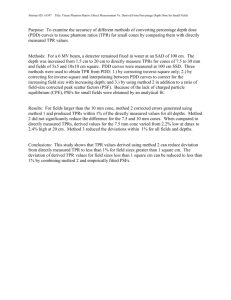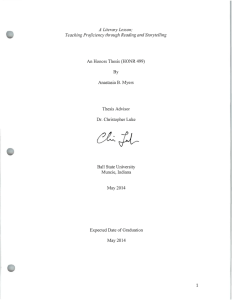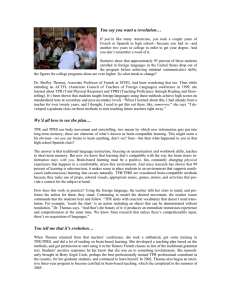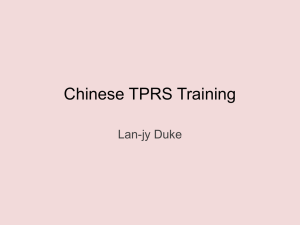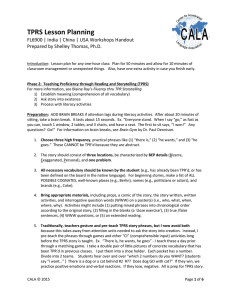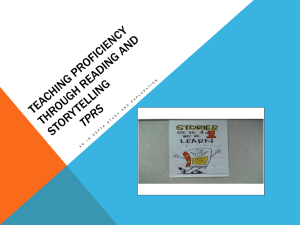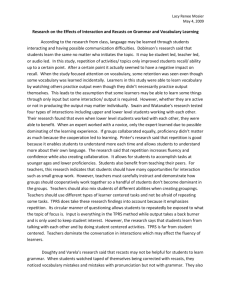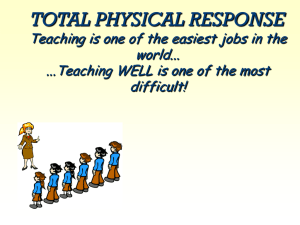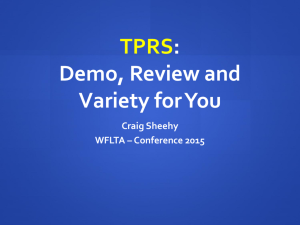TEYL ppt - Technology4TEFL
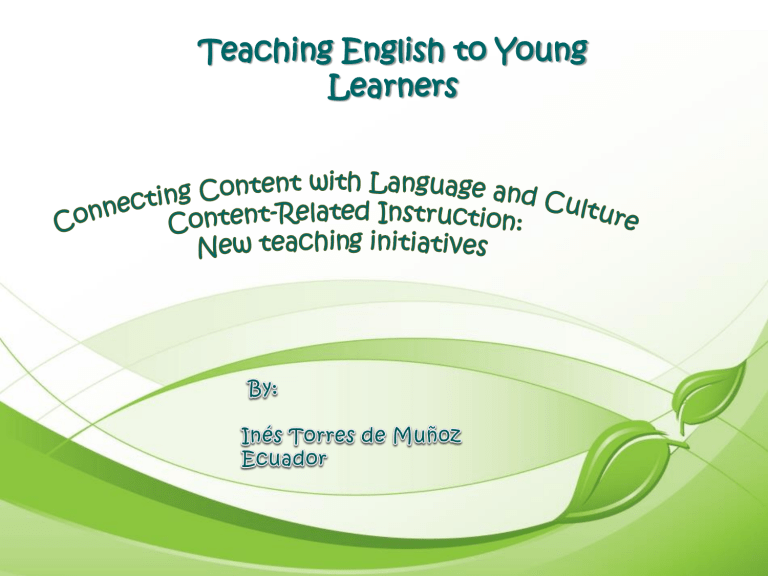
Teaching English to Young
Learners
Use the regular curriculum as vehicle for making language activities more cognitively engaging.
• Provides learners with the skills and the practice needed to acquire information in the target language.
• Connects English language curriculum with other parts of learners’ academic lives.
• Integrates language development with content learning.
• Enriches concepts learned in other content areas with the unique experiences and insights available through language study.
According to Bernard Mohan (1986) :
• Language teaching by content teaching in which the focus is on content, and the language competences develop almost incidentally.
• Language Teaching with Content Teaching in where the focus is on teaching both language and content.
• Language Teaching for Content Teaching in which students learn the specific language needed for success in various subjects as quickly as possible.
1. Communicative Competence can be develop as students feel the need to exchange information with one another or with the teacher in real communicative settings.
2. Provides a meaningful context for language use, and encourages language use for interesting and engaging purposes.
3. Fills the need for “comprehensive input” as described by Krashen.
4. The language used is supported by contextual cues, often in the form of visuals or concrete objects.
5. Supports what we know about how the brain makes connections and how learning takes place.
6. Students are actively engaged in constructing meaning and making sense of the interesting world presented to them through the vehicle of
English.
• Curriculum areas such as physical education, family and customer education, health, art and music have potential for contend-related instructions.
• In TEYL specifically areas such as the social studies, mathematics, and science are potential for content-related instructions.
• These areas deal with highly experiential, often very visual learning, the use of second language in communicating the concepts can be natural and successful alternative for instructions.
• The content –area skills and concepts that can interrelate most effectively with the language goals.
• The language competences needed to work with the content selected.
• The cognitive skills necessary to perform the task in the lesson.
• The potential for integration with language goals and culture concepts and goals.
• Consideration #1
Curriculum Resources
The best sources are the curriculum documents for the subject areas at the primary school level.
• Consideration #2
Teach-ability through English
Teacher look for concepts that lend themselves specially well to the kind of concrete, hands-on, activity-oriented teaching that is necessary in the early language classroom.
• Content-Compatible Language draw from the language curriculum, is that language for which the curriculum concept or information provides a convenient context.
• Content-Obligatory Language is the language that must be taught in order to teach or reinforce the curriculum concept ,draw from content curriculum.
Availability of Relevant Materials.
•
• Early in the planning process it is important to identify the instructional materials teacher will use.
According to Echeverria and Graves
(2007) the following techniques can be useful for adapting materials:
1. Using graphic depiction
2. Outlining the text
3. Rewriting the text
4. Using audiotapes
5. Providing live demonstrations
6. Use alternate books Source:http://www.texasvis.com/Indeximages
/VIS-Tree.jpg
TPR
TPR
Teachers interact with students by delivering commands, and students demonstrate comprehension through physical response. The following sequence is recommended by Betty Segal
(no date)
2
1
Commands involving the entire body, large motor skills.
Commands involving interaction with concrete materials and manipulative, beginning with classroom objects
• Point to your ear.
• Put your left hand on your head and turn three times.
Take the red circle and place it in the waste basket.
3
Commands relating to pictures , maps, numbers and other indirect materials.
Go to the picture of the bathroom and (pretend to) brush your teeth.
TPRS
• It is an approach to combining language with actions and story.
• It is based on TPR and Natural Approach.
• It embeds new vocabulary and structures and structures as functional chunks in a story line and provides extensive listening practice before students are expected to speak.
• Clearly moves from the interpersonal mode of communication into a limited experience with presentational communication, both oral and written.
TPRS
TPRS
TPRS
TPRS
TPRS
TPRS
Natural
Approach
Comprehension
(preproduction)
Student Stage #1 a.
TPR b. Description of pictures and persons.
Early speech production
Speech emerges
Student Stage #2 a.
Yes-No questions.
b. Either-or questions c. Single/two words answers.
d. Open ended sentences e.
Open dialogues f.
Interviews
Student Stage #1 a.
Games and recreational activities.
b. Content activities.
c. Humanistic-affective activities.
d. Information-problem-solving activities.
• Students should have bought some knowledge information about animals in danger in Ecuador and some knowledge about present and past simple verb forms for this lesson.
• Skills to be emphasized:
• Extensive reading skills
• Speaking skill
• Content :
• Students will be able to communicate information, ideas, and opinions through a text that built students’ awareness of endangered birds in
Ecuador.
•
• To develop extensive reading skills
• To develop speaking skills and practice asking for and giving information.
• To build students awareness of birds which are endangered in
Ecuador
Posters, pictures, board,
Book
Pencil
Color pencils
Computer
In-focus board
Source:
Our World Through English
Book 3. New Edition. This book is used to teach
English as Foreign Language in all public schools of
Ecuador.
Teacher asks students to see a
YouTube video http://www.youtube.com/watch?v
=SawTH5w2eR8&feature=related
Then she asks them to comment about what they have seemed in the video.
Finally, Teacher encourages students to say what they know about condor bird.
• Task 1:
Predicting information
Teacher focuses students’ attention on the poster and asks them some question in order to conduct a brief classroom discussion (The poster is about awareness endangered birds in
Ecuador).
• Task 2:
Reading and completing information
Teacher asks students to read the task instructions and check the understanding, and then, teacher divides the classroom into three groups As, Bs and
Cs. As read about condors, Bs read about Yumbos,
Cs read about Macaws.
Teacher ensures they understand that they only have to read one text. Then, teacher gives students enough time to read silently and to complete the table. While students are working, draw a similar table on the board. Do not write the answers in the table. Do not check the task with the whole group, but help students as monitor if necessary.
• Task: 3
Speaking
Ask students to read the task instructions. Check their comprehension on the topic. Then organize students into groups of three give them a passage to read. Tell them to ask each other about the birds’ passages they didn’t have the opportunity to read in order to complete the information on the table. Teacher demonstrates the task, and then, teacher asks one group to come up to the board. Encourage B and C groups to ask A group one question about condors and fill in a space in their tables on the board.
• Encourage A to ask B and C a question and fill in the corresponding space in his or her table on the board.
Guided students practice:
• Bring the students together in small groups.
•
Small group practice activity:
In groups students will read the passage information. Next, tell them to ask each other students some questions about the bird passages they didn’t have the opportunity to read in order to complete the information in the table.
Evaluation :
Students will be assessed in groups. They will ask and answer each other questions about the topic they have read.
Follow up:
Encourage students from group A to ask B and C a question and fill in the corresponding space in his or her table on the board. As this class is the last class of unit six. Teacher asks students to see a YouTube video http://www.youtube.com/watch?v=gv
YvLD_BVJ0 and then she asks them to comment about what they have seemed in the video. Teacher encourages students to recognize the wild animals, insect, and birds that they have studied in this unit.
